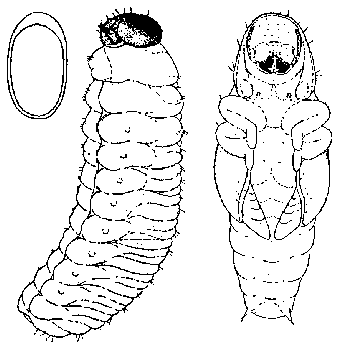
Hylurdrectonus
araucariae (Schedl)
(Coleoptera:
Scolytidae)
go to main menu
Apart from termites, the minute Scolytidae beetle Hylurdrectonus araucariae is the most destructive pest of young Araucaria cunninghamii in the Bulolo-Wau area. Seedlings and older trees are rarely targeted by the beetle, however four to 12 year old trees are the most susceptible. Hoop pine seems to be the only host of this beetle. Records of the first Hylurdrectonus araucariae outbreak date back to the late fifties, followed by a very severe infestation starting in 1966 and lasting until the early seventies. During the peak of the outbreak in 1972, 47.5% of the 3252 ha of planted Hoop pine at Bulolo and 91% out of 1186 ha at Wau were severely infested by the beetle. As a result of this calamity, any further planting of Hoop pines was abandoned. The tremendous economic loss justified ULVA spraying of Propoxurâ in the early seventies. After the treatment, the population of the beetle decreased considerably, however regular monitoring up to the present time shows evidence of the beetle in Hoop plantations. The attacks seem to have become more serious since 1996 at Wau and since 1997 at Bulolo and call for an appropriate control programme of the beetle in order to avoid another major set-back to the plantation.
The black adult beetles are of 1.5 to 2 mm body length and can be easily found together with eggs, larvae and pupae in the branchlets of an infested tree. The beetles bore entrance holes of about 0.5 mm diameter into the base of the needles and mine further into the cortex of the branchlets. The eggs are laid into the excavated galleries, where all stages of the life cycle develop and live together in a community. The day-flying adult beetles develop within three to six weeks from the egg and have a life span of about two months. The number of individuals per nest varies between 10 and 60. Both, larvae and adults are responsible for the damage. Natural enemies of Hylurdrectonus are unknown.

Life cycle of Hylurdrectonus
araucariae and entrance hole in leaf of host
tree (right)
(drawing reproduced from Gray, B., 1968)
At the initial stage of the infestation the branches of the lower or middle portion of the crown are affected. As a result of the cortex mining, the transport of nutrients and water is disrupted so that the affected branchlets wilt. The colour of the needles subsequently changes from green to yellow and brown. The wilt always starts at a distinct area, where the nest is located and proceeds further towards the tip of the branchlet. During the further progress of the infestation, the branches of the middle and upper crown, and finally the leader are affected, resulting in defoliation and loss of increment. Less vigorous trees die after two to six years of a severe attack.
Symptoms of Hylurdrectonus
araucariae attack
Hylurdrectonus araucariae outbreaks occur periodically. However, proper hygiene in the plantation and other preventive measures contribute a lot towards preventing outbreaks. Therefore, the silvicultural treatments such as tending and pruning should not be delayed but carried out as early as possible. In the early stage of the attack high pruning and the burning of the affected branches is recommended. This is definitely an environmentally sound measure for the control of the beetle. The feasibility however seems to be doubtful since such an exercise is very time consuming and labour intensive, apart from the fire hazard arising from the combustion of the pruned branches. The application of a suitable insecticide is the most expensive measure and is only justified in case of a very severe economic loss, for instance, if the upper crowns of most trees in almost all parts of the plantation are already severely affected. Due to the tree height, the difficult topography and thermal winds in PNG, chemical methods require a helicopter for the proper application of insecticides.
go to general info on
coleopteran pests
go to host
trees and their pests
go to glossary
go to main menu
© Michael F. Schneider, 1999